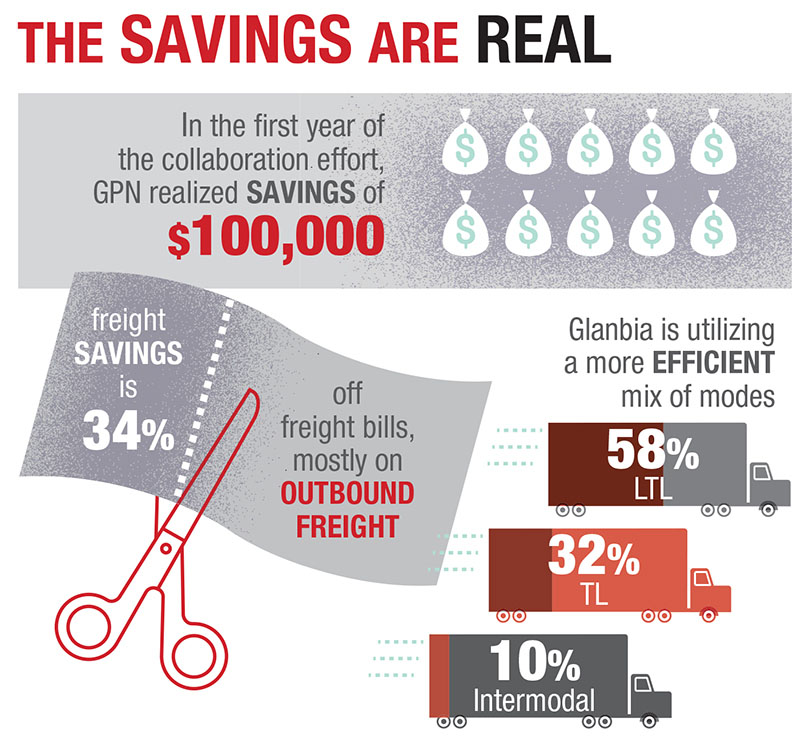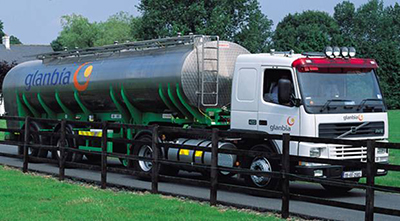Improving 3PL Management: Glanbia Adds Muscle to Logistics
In an award-winning collaboration effort with a 3PL and TL partner, this global performance nutrition company has drastically reduced costs—all while improving service through and innovative “embedded” arrangement.
Glanbia Performance Nutrition (GPN), a $1.1 billion company based in Dublin, Ireland, bills itself as the No. 1 global performance nutrition brand in the world with products designed for the fast-growing fitness market. Looking to trim some of its own fat, GPN’s U.S. subsidiary put itself on a logistics fitness regimen three years ago—one that’s helped it reduce costs, transit times and claims while increasing efficiency through a unique collaborative relationship with its third-party logistics provider.
As a vital part of this regimen, Glanbia outsourced its freight management to third-party logistics provider (3PL) Transplace back in May 2014 in order to develop innovative ways to reduce its transportation cost and improve overall service.
As the 3PL partner dug into the data, it determined that Glanbia’s claims ratios were greater than the industry average—a pain point that ended up being the starting point to help reduce the company’s overall transportation costs. Transplace immediately enacted processes to help reduce the claims ratio, implementing its TransMATCH load-sharing program that helped reduce the claims ratio further.
Under this program, the 3PL partner created multi-stop shipments within Glanbia’s network, as well as determined opportunities outside its network to achieve the benefits of multi-stop truckloads. To help in this stage of the solution, the partners chose Illinois-based truckload carrier Best Solution Express to be the key asset carrier to handle much of the multi-stop moves.
“The main driver was really about consolidating LTL to get cost improvements and reduce transit times,” says Kurt Hepker, Glanbia’s director of logistics. “Truckload damages are much less than LTL because the freight gets handled so many fewer times.”

Besides the strategic and operational changes, Hepker says that one of the key ingredients was the human element. Danielle Arriaga, operations manager for Transplace, is one of three 3PL employees who are embedded at Glanbia to make sure operations are humming and efficiencies are gained going forward.
“Most days I’m pretty involved in their whole operation,” says Arriaga. “Being on site in the shipping office is crucial. I’m sitting next to the person in shipping who pulls their orders, and we’re communicating all the time about co-loading and what loads we can combine. Every time she hears the word ‘co-load,’ we realize e can save money.”
Now, let’s take a deep dive into how the Glanbia, Transplace and Best Solution Express collaboration works and highlight the quantifiable savings and operations improvements that earned this team a 2017 Alliance Award.
Editor’s Note:
 The successful partnership forged by Glanbia Performance Nutrition, Transplace and Best Solution Express was awarded a 2017 Alliance Award. The Alliance Awards, sponsored by Logistics Management and SMC³, recognize how shippers and their service providers work together to overcome challenges to critical components of their unique supply chains. Winners are singled out for their ability to effectively solve challenges through innovative, measurable means. Entries for the 2018 Alliance Awards will soon be accepted at logisticsmgmt.com.
The successful partnership forged by Glanbia Performance Nutrition, Transplace and Best Solution Express was awarded a 2017 Alliance Award. The Alliance Awards, sponsored by Logistics Management and SMC³, recognize how shippers and their service providers work together to overcome challenges to critical components of their unique supply chains. Winners are singled out for their ability to effectively solve challenges through innovative, measurable means. Entries for the 2018 Alliance Awards will soon be accepted at logisticsmgmt.com.
Define the needs, develop the solution
There were a couple pieces that needed to fall into place. First, Transplace had to fully analyze the situation and find the trucking partner (Best Solution) that had the geographic coverage and ability to handle the freight demands. Second, Glanbia had to define the specific goals they were looking to achieve then make sure the collaborative effort was laser-focused on meeting them.
After much deliberation, the team decided that the solution needed to:
- Reduce cost focusing on shipments in the 5,000-pound to 30,000-pound range and shipments that utilize 12 feetto 30 feet of truck space.
- Reduce claims ratio.
- Reduce handling and exposure to outside risks.
- Improve transit time and on-time percentage to consignees.
As with many transportation partnerships, the solution also came with ancillary benefits. “One of the side benefits was reduction in damages, but the main driver was consolidating freight, claims reduction and transit times,” says Hepker. “The real key piece was working with Transplace to find ways to gain service improvements and cost reductions.”
The key was Transplace consolidating myriad LTL shipments to get cost improvements and reduce transit through greater use of full truckload. Truckload freight is handled less and usually results in fewer damages than LTL.
“When I first got here and looked at the mix of freight and pallet counts, I put things together that opened their eyes,” says Arriaga. “We started combining loads and putting freight on the same truck to save money.”
According to Arriaga, there was “a lot of opportunity” to do that within Glanbia’s customer base; however, there were also other Transplace customers shipping in roughly the same geographic regions. This opened up other opportunities to save money and reduce claims.
Showcase of collaboration
In a world of instant, global communication, Transplace and Glanbia are proof that old school face-to-face still works just as well in the age of digital logistics management—maybe even better in some cases.
Arriaga is one of three employees embedded on site at GNP headquarters in Downers Grove, Ill., as well as at the distribution center in nearby Aurora. “The on-site team takes communication to another level,” says Hepker. “They can see first hand what freight is changing and what opportunities need to be made.
Everyday Hepker is on a conference call with his warehousing team to discuss issues on the ground as well as corrective measures. In addition, there are weekly long-range planning calls with the wider group of Transplace planners, followed by monthly and quarterly business reviews. In the end, little is left
to chance.
Before her career at Transplace, Arriaga worked at LMS Logistics, a provider that specialized in embedding people on site for projects. “That was our niche,” she recalls. “It was new to Transplace, but they’ve seen the benefits of having people in a client’s operations.”
According to Hepker, that is a growing trend in the industry—and for good reason. “There’s an enormous amount of collaboration and planning involved when implementing a seamless multi-stop truckload solution across numerous shippers,” he says. “Having a person in-house and onsite just makes the solution that much simpler.”
Collaboration among Transplace, Glanbia and Best Solution—the primary TL partner—was critical to achieving the goals set for the program, but there was additional collaboration needed with other shippers included within the TransMATCH program.
With Transplace’s visibility of Glanbia’s network, the team determines shipments that are eligible for the program and then plans and identifies candidates for those shipments. Transplace sends this information to its transportation management system (TMS) where a multi-stop truckload solution is created. During this process, the 3PL and Best Solution work closely each step of the way to execute to the plan.
The results of the collaboration have been realized through reduced transit time, improved on-time percentage, and reduced damage—all while they watched costs decrease. And both Hepker and Arriaga agree that it’s really the industry experience and institutional knowledge that really make it all work.
“You just know places where a lot of freight goes,” says Arriaga. “For example, a lot of West Coast-bound freight is co-loadable, so as soon as we get stuff going west, we know what to look for. Our group is good at saying: ‘I have this load. Do you have anything going that way’?
All the pieces are working
The final piece of the puzzle involved getting suitable freight from other shippers in order to make Glanbia’s freight solution cost effective. To do this, Transplace leveraged its load-matching optimization solution that opens up a network of shippers to help create the ideal load.
According to Arriaga and the Transplace team, Best Solution’s nationwide network was able to support Glanbia’s unique needs and has a driver base that’s able to accommodate the numerous stops and handling that’s involved—a characteristic that she believes isn’t typical among TL carriers.
For example, a shipment that was recently moved from Glanbia in Aurora on a Thursday going to Van Nuys, Calif., weighing approximately 13,000 pounds was taking up approximately 26 feet of truck space. Transplace was able to load this shipment with other shipments—not belonging to Glanbia—going to Las Vegas weighing 18,250 pounds and taking up approximately 24 feet of truck space.
Through coordination between the shipping facilities and Best Solution, the carrier was able to load the shipments to deliver in proper order to reduce miles traveled and handling. “Being that these shipments were over the typical LTL linear foot allowed under standard LTL pricing, it’s likely that both would have been moved as full truckloads—with more than half of the trailer empty,” says Hepker.
According to Arriaga, typical LTL transit time would have this shipment arriving in seven days; but through this solution, it was delivered in five. Glanbia also says it was able to save over 30% on this move as a result.
Quantifiable results
The savings are real. In the first year of the collaboration effort, Hepker estimates that GPN realized $100,000 in savings—a number he knows is tracking higher today. And when he boils it down, actual freight savings is 34% off freight bills, mostly on outbound freight. Glanbia is also utilizing a more efficient mix of modes. Its current modal mix is 58% on LTL, 32 % TL, and 10% intermodal.
“We look at it lot of different ways,” says Hepker referring to the benefits. “Cost is a big one, but not the only one. Transit times reductions are a significant benefit, and one that makes our customers happy.” Ancillary benefits are lower claims as a result of less handling of the freight and environmental benefits to help Glanbia in areas of sustainability.
According to Hepker, overall supply chain operations have seen a number of benefits as well. Most notably, Glanbia is now able to deliver to customers faster and more efficiently while providing security to their products.
Going forward, more of Glanbia’s shipments will be included within the project leading, hopefully, to greater shipment improvements and cost savings across the board. Removing high weight shipments in the 12-linear to 30-linear-foot range from LTL carriers will not only help LTL carriers improve on their operating ratio, but will also help them improve their overall service.
The U.S. Glanbia Performance Nutritional division is only about eight years old, but has made seven acquisitions over that relatively short period of time. “That’s another reason we outsource,” says Hepker. “We’re growing so rapidly, and with that many acquisitions it’s difficult to integrate a bunch of disparate transportation programs. As we continue to grow, this benefit extends to other businesses we acquire. It’s just more opportunity to take that model and make it work.”













